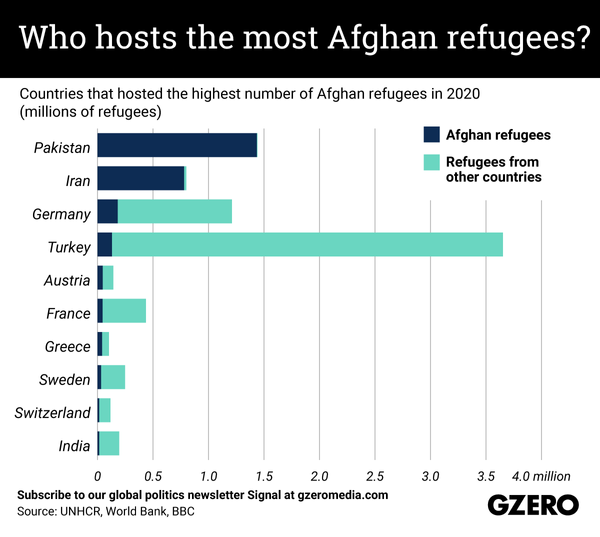The Daily Escape:

Cathedral Valley, Capitol Reef NP – photo by Richard Strange
The White House reported that 21,600 people have been evacuated from Kabul in the last 24 hours, bringing the total to 58,700 persons evacuated. But there’s already a 50,000-person backlog for US visas for non-governmental organization workers.
Today, let’s talk about 1) Where these Afghan refugees are headed, and 2) The Special Immigration Visa (SIV) program in the US that has come under criticism from politicians and the media.
Let’s start with the SIV program. The State Department has allocated 50,000 SIVs for Afghanistan. PBS reported yesterday that 34,500 of them are already allocated, while about 300,000 Afghans have some history of working with the US, and therefore, may be at risk of reprisal from the Taliban.
Wrongo listened to Congressman Mike Gallagher (R-WI) who is trying to assist a few Afghans with US visas, say that the reason for the backlog is lack of planning by the Biden administration. That’s untrue. Sen. Chris Murphy (D-CT) introduces some reality into the discussion of the SIV backlog:
“Over the last decade, Republicans have pushed to intentionally create a massive backlog in the Special Immigrant Visa (SIV) program – the one we use to bring Afghan partners to America, by putting onerous conditions on the applications…In 2016, Obama asked to increase the cap for the SIV program. Senate Republicans objected. Then, the Trump Admin started slowing down SIV processing. When Biden took over, there were 10,000 unfilled visas, despite 17,000 applications in the pipeline.”
Sen. Murphy continues: (parenthesis and emphasis by Wrongo)
“Obama admitted over 2,700 Afghan refugees. Trump admitted 400, bc (because) he had dismantled the refugee system. Biden had to rebuild it. And today Trump Republicans are making it clear they will oppose bringing more Afghan refugees to the US. Steven Miller: ‘Resettling [Afghans] in America is not about solving a humanitarian crisis; it’s about accomplishing an ideological objective to change America.’”
Is anyone more repellent than Steven Miller?
Any reporting by the media about the “chaos” in Afghanistan that doesn’t include these facts, isn’t worth your time. Also, let’s differentiate between what’s happening within US control, from what’s happening beyond our control: All the chaos is happening outside of the Kabul airport gates.
Inside, we’re moving thousands of people in a largely orderly fashion to intermediate countries, where the process of their immigration can begin.
This is by far the biggest military evacuation in US history, and it’s being handled surprisingly well. That might change in an instant, anything could happen. But so far, the US media has been suckered into a chaos narrative that’s almost precisely the opposite of the truth.
GZero has an illuminating report on Afghan refugees. They say that the Afghan refugee problem will mushroom into a global crisis this year:
“More than half a million Afghans had already fled violence and instability in their country this year alone, even before the Taliban swept back to power a week ago. But an equal number of new refugees could very well hit the road in the next few months, despite Taliban efforts to stop people from leaving.”
Here’s a chart showing where Afghan refugees are located. Pakistan has nearly 1.5 million while Iran has about 800k:

GZero reports that Europe currently hosts 780,000 Afghan refugees, second only to Pakistan, along with another two million undocumented Afghans. Iran is worried that the Taliban, who are Sunni extremists, may intensify a long history of persecution of Afghanistan’s Shia minorities, pushing even more refugees across the Iranian border. GZero asks:
“This all raises the question: What happens if possibly millions of people who fear persecution get trapped inside their own country? They will probably join the ranks of the 3.5 million vulnerable Afghans who are already internally displaced.”
Since the White House just announced that the US will stick to August 31 as the end date for the airlift of refuges and the complete withdrawal of our troops from Afghanistan, no one knows what will happen to those people left in Afghanistan who have expressed a desire to leave.
Other countries could work to repatriate their citizens by negotiating directly with the Taliban. Most likely, GZero’s prediction of a large internally displaced population will come to pass.
Biden’s decision is certain to spark criticism at home and abroad. Those faulting Biden should answer: Weren’t they originally all for ending this war and taking our troops out? What is the US supposed to do when not even $2 trillion over 20 years was enough?
While you ponder what to do, listen to James McMurtry’s new tune, “Operation Never Mind“, from his new album out this week, “The Horses and the Hounds”. The song is about how Americans think about our soldiers:
Sample lyric:
we got an operation goin’ on
it don’t have to trouble me and you
the country boys will do the fighting
now that fighting’s all a country boy can do
we got a handle on it this time
no one’s gonna tell us we were wrong
we won’t let the cameras near the fighting
that way we won’t have another Vietnam
(chorus) no one knows,
‘cause no one sees no one cares,
‘cause no one knows no one knows,
‘cause no one sees it on TV
don’t they look just like on “SEAL Team”
Lord don’t they look the best
when we trot them out at halftime
or the seventh inning stretch
they stand up in their uniforms and help us sell the show
dying by their own hands for reasons we don’t know

I see some readjustment on the “Biden chaos” trope as the impressive number of exit flights continue. My own analysis is that the failure to prepare lists of pre-approved Afgans is the really basic failure. Of course, some of that may reasonably assigned to the new administration, but it mostly lies with the previous one that not only did not prepare such a list, but hollowed out the State Department staff that could have acted quicker and blocked legislative action that might have speeded the process when exit time arrived.